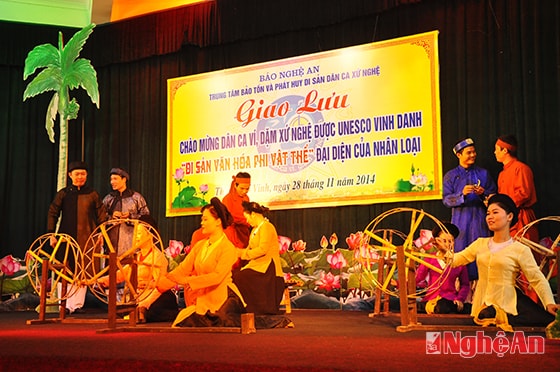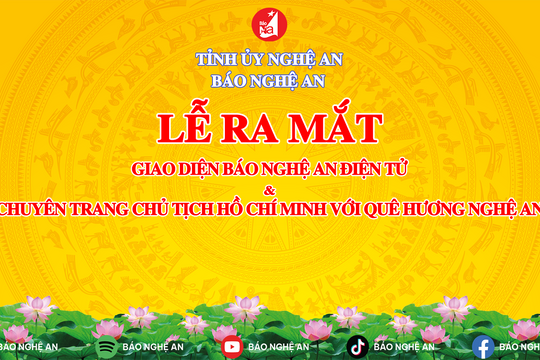Language in wallet, Nghe Tinh miles
(Baonghean) - Nghe Tinh, the land of green mountains and blue waters, has a treasure trove of unique folk poetry, in which Vi and Dam are two of the most unique folk performance genres. Vi and Dam of Nghe Tinh are a treasure trove that contributes to identifying the local cultural identity within the national whole, and is also a certificate of international integration following the globalization trend.
(Baonghean) - Nghe Tinh, the land of green mountains and blue waters, has a treasure trove of unique folk poetry, in which Vi and Dam are two of the most unique folk performance genres. Vi and Dam of Nghe Tinh are a treasure trove that contributes to identifying the local cultural identity within the national whole, and is also a certificate of international integration following the globalization trend.
For generations, Nghe Tinh people have spoken Nghe dialect, which is the variations and forms of Vietnamese language in Nghe Tinh. Therefore, Nghe Tinh folk songs and proverbs are a combination of the most wonderful artistic features of the Vietnamese language of the whole people and the quintessential features of Nghe dialect. In Nghe Tinh folk songs and proverbs, we not only encounter polished, smooth, and subtle ways of speaking, but also rustic, awkward expressions and local colloquial expressions. It is the cross-combination of these linguistic forms that creates the unique and distinctive features of Nghe Tinh folk songs and proverbs.
| RELATED NEWS |
|---|
 |
| The performance "Love Song of Fabric Ward" was performed by artists from the Center for Preservation and Promotion of Nghe An Folk Heritage. Photo: Cong Manh |
Vi and dam songs are popular folk songs, in which many words are very refined, smooth, and subtle, expressing the poetic way of thinking and feeling of the boys and girls of Nghe Tinh. For example, this is a way to express and measure feelings: How many meters is Hong Son high/ How many meters is Lam Giang, how much is the heart (Hat phuong vai). Moreover, the words in many Vi and dam songs are rich in imagery, highly symbolic, and have a very clear "poetic" quality. For example: Mossy rocks are because of standing water/ White-haired mountains are because of falling dew; When returning, I tell the water and the mountains/ Tell them that a square and round word is a husband and wife,... (Hat phuong vai); or: Mother stopped and stood still/ Afraid of the evening sun, fading flowers/ Afraid of double wind, single rain/ For this fate to be regretful/ For this fate to be regretful,... (Hat giam).
Regarding comparisons, the folk songs mainly use “open” comparisons (with almost all the comparison formulas), using things that are very close in life, but still create subtle associations. For example: Your skin is like a young banana shoot/ Your waist is as narrow as a wasp (Hat phuong vai); Or: Your belly is as round as a jar of fermented bean curd/ Fat as a buffalo (Hat dam).
In the folk songs of Nghe Tinh, metaphors are used the most. Folk authors use metaphors to convey their feelings. In many cases, this artistic device creates eloquent and subtle ways of speaking about things that are difficult to say and not easy to express. For example: The phoenix is very wild and not smart/ Instead of landing on Tam Thai mountain, it lands on the grass hill (Hat phuong vai); Or: The bee has come and gone several times/ The butterfly has passed by several times/ Leaving the willow tree a bit of its body/ Feeling sorry for the shallowness in my heart (Hat dam),...
Personification is also used in the folk song to talk about landscapes, weather information, or express human feelings. For example, the personification in the folk song "Ru Bong has not worn a hat yet/ Ru Be has not brought a toi" is information about the weather that it has not rained yet. Or: "The fruit garden has red cheeks/ Plums and apricots wrap around tangerines and gives oranges" (Hat phuong vai) both describes the close relationship between boys and girls and introduces the fruit garden, including seven types of fruit: star apple, persimmon, plum, apricot, tangerine, orange, and orange (personification combined with wordplay). How surprising and interesting.
Hyperbole (also called hyperbole, allegory) - a rhetorical method that creates a strong impression by expressing many times the attributes of things and phenomena, also appears frequently in Nghe Tinh similes and metaphors. For example: Even if someone gouges out your eyes or cuts off your hands/ You will still follow this path with me (Hat phuong vai); We have sworn/ We are determined to live and die together/ Even if the sea is deep or the mountain is high/ Even if the sword is at our head/ We must take every step/ We must take every step (Hat dam). Such ways of speaking express the high determination of love between couples.
One of the characteristics that makes Nghe Tinh vi and dam songs easy to enter people's hearts is the depth and poignancy of the melody. Vi and dam melody is formed mainly from rhyme and rhythm breaks. Regarding rhyme, because most vi and dam songs are composed in the six-eight (vi) or five-word (dam) form, the sentences are always connected together by rhyming at certain positions. That is the type of back rhyme in vi singing. For example: "When Hong Linh stone wears away/ Hoanh Son clouds cover, my heart still remembers you". That is the foot rhyme in dam singing. For example: Even though the sea is dry, the stone wears away/ My heart is still red/ I know when it will fade/ I know when it will fade,... The rhyme in vi and dam is mostly the main rhyme, therefore, the harmonic function of the rhyme is maximized. In many cases, even the syllables (sounds) in the sentence also rhyme with each other, increasing the resonance of the vi and dam sentences. For example: “Passing by, I hear your cheers/ I hear you from afar, I want to carry you home”; or: A pair of red-lacquered chopsticks/ Pick up a red ash/ Put it in a golden basket/ Coming here, the village is far away/ I wish I could have a phoenix cross over the dragon…
In Nghe Tinh folk songs, rhythm breaks not only serve the function of separating sentence components and sentences, but also serve the function of maintaining musicality, thereby increasing the power of expressing meaning, contributing to expressing the content of folk songs and miles. Therefore, rhythm breaks in Nghe Tinh folk songs and miles are not always smooth and peaceful, but vary according to the inspiration of the lyrical subject, thereby creating polyphony. For example: Don't/ play chess/ play chess/ play silver/ Don't/ drink wine/ drink tea/ tea/ Don't/ invite friends/ invite friends/ Don't/ listen to people's mouths/ Don't/ listen to people's mouths (Hat Dam). Or: One/ is fate/ is debt/ Two/ because of mother/ because of teacher/ Three/ because of fate, who here// Make this fate feel guilty// Make this fate feel guilty (Hat Dam). These examples show us that the rhythm in folk songs and miles is as rough and diverse as the difficult life of Nghe Tinh workers.
It can be said that Nghe Tinh's wallet and miles contain within them unique characteristics and features of the way of thinking, aesthetic views, human ethics, ways of behaving, attitudes towards good and evil,... of a geographical and residential area.
TS.Nguyen Hoai Nguyen
(Faculty of Literature - Vinh University)

.png)






